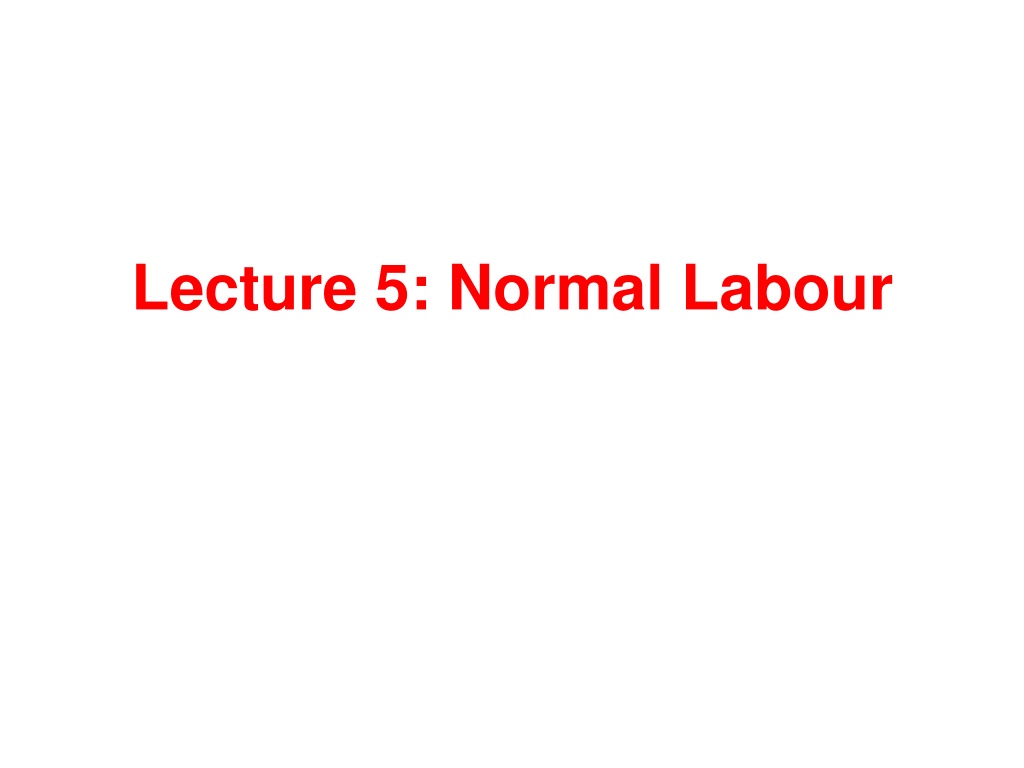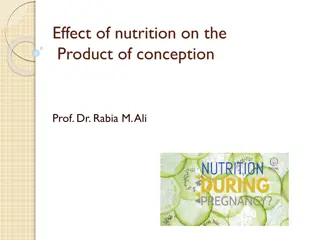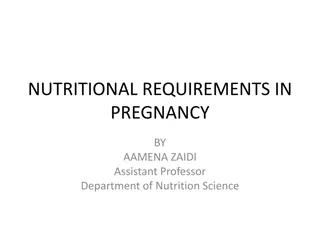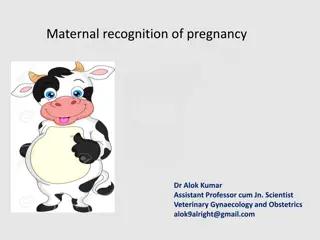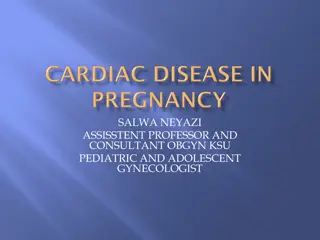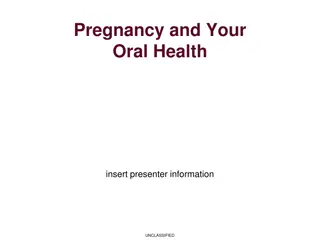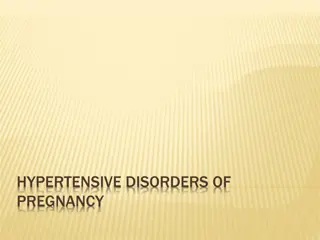Understanding Normal Labour in Pregnancy
Labour is the natural process of expelling a mature foetus from the uterus. Criteria for normal labour include spontaneous expulsion of a single, mature foetus within a reasonable time frame without complications. Various theories explain the onset of labour, such as hormonal factors and mechanical factors. The clinical picture of labour includes prodromal symptoms like shelfing and lightening. Understanding the stages and signs of normal labour is crucial for expectant mothers and healthcare providers.
Download Presentation

Please find below an Image/Link to download the presentation.
The content on the website is provided AS IS for your information and personal use only. It may not be sold, licensed, or shared on other websites without obtaining consent from the author. Download presentation by click this link. If you encounter any issues during the download, it is possible that the publisher has removed the file from their server.
E N D
Presentation Transcript
Definitions Labour is the process by which a viable foetus i.e. at the end of 28 weeks or more is expelled or is going to be expelled from the uterus. Delivery means actual birth of the foetus. The following criteria should be present to call it normal labour: Spontaneous expulsion, of a single, mature foetus, presented by vertex, through the birth canal, within a reasonable time (not less than 3 hours or more than 18 hours), without complications to the mother, or the foetus.
Cause of Onset of Labour It is unknown but the following theories were postulated: Hormonal factors Oestrogen theory: During pregnancy, most of the oestrogens are present in a binding form. During the last trimester, more free oestrogen appears increasing the excitability of the myometrium and prostaglandins synthesis. o Progesterone withdrawal theory: Before labour, there is a drop in progesterone synthesis leading to predominance of the excitatory action of oestrogens. o Prostaglandins theory: Prostaglandins E2 and F2 are powerful stimulators of uterine muscle activity. PGF2 was found to be increased in maternal and foetal blood as well as the amniotic fluid late in pregnancy and during labour. o
Oxytocin theory: Although oxytocin is a powerful stimulator of uterine contraction, its natural role in onset of labour is doubtful. The secretion of oxytocinase enzyme from the placenta is decreased near term due to placental ischaemia leading to predominance of oxytocin s action. o Foetal cortisol theory: Increased cortisol production from the foetal adrenal gland before labour may influence its onset by increasing oestrogen production from the placenta. o
Mechanical factors Uterine distension theory: Like any hollow organ in the body, when the uterus in distended to a certain limit, it starts to contract to evacuate its contents. This explains the preterm labour in case of multiple pregnancy and polyhydramnios. o Stretch of the lower uterine segment: by the presenting part near term. o
CLINICAL PICTURE OF LABOUR Prodromal (pre-labour) stage The following clinical manifestations may occur in the last weeks of pregnancy. Shelfing: It is falling forwards of the uterine fundus making the upper abdomen looks like a shelf during standing position. This is due to engagement of the head which brings the foetus perpendicular to the pelvic inlet in the direction of pelvic axis. o Lightening: It is the relief of upper abdominal pressure symptoms as dyspnoea, dyspepsia and palpitation due to: o descent in the fundal level after engagement of the head and shelfing of the uterus.
These are differentiated from true labour pain as follow: True Labour Pain False Labour Pain Regular. Irregular. Increase progressively in frequency, duration and intensity. Do not. Pain is felt in the abdomen and radiating to the back. Pain is felt mainly in the abdomen. Progressive dilatation and effacement of the cervix. No effect on the cervix. Membranes are bulging during contractions. No bulging of the membranes. Not relieved by antispasmodics or sedatives. Can be relieved by antispasmodics and sedatives.
Onset of Labour It is characterised by: True labour pain. The show: It is an expelled cervical mucus plug tinged with blood from ruptured small vessels as a result of separation of the membranes from the lower uterine segment. Labour is usually starts several hours to few days after show. o Dilatation of the cervix: A closed cervix is a reliable sign that labour has not begun. In multigravidae the cervix may admit the tip of the finger before onset of labour. o Formation of the bag of fore-waters: It bulges through the cervix and becomes tense during uterine contractions. o
STAGES OF LABOUR Labour is divided into four stages: First stage It is the stage of cervical dilatation. o Starts with the onset of true labour pain and ends with full dilatation of the cervix i.e. 10 cm in diameter. o It takes about 10-14 hours in primigravida and about 6-8 hours in multipara. o Second stage It is the stage of expulsion of the foetus. o Begins with full cervical dilatation and ends with the delivery of the foetus. o Its duration is about 1 hour in primigravida and hour in multipara. o
Third stage It is the stage of expulsion of the placenta and membranes. o Begins after delivery of the foetus and ends with expulsion of the placenta and membranes. o Its duration is about 10-20 minutes in both primi and multipara. o Fourth stage It is the stage of early recovery. o Begins immediately after expulsion of the placenta and membranes and lasts for one hour. o During which careful observation for the patient, particularly for signs of postpartum haemorrhage is essential. Routine uterine massage is usually done every 15 minutes during this period. o
First Stage Causes of cervical dilatation Contraction and retraction of uterine musculature. Mechanical pressure by the forebag of waters, if membranes still intact, or the presenting part, if they had ruptured. This in turn will release more prostaglandins which stimulate uterine contractions and cervical effacement. Softness of the cervix which has occurred during pregnancy facilitates dilatation and effacement of the cervix.
Mechanism of cervical dilatation In primigravidas, the cervical canal dilates from above downwards i.e. from the internal os downwards to the external os. So its length shorts gradually from more than 2 cm to a thin rim of few millimetres continuous with the lower uterine segment. This process is called effacement and expressed in percentage so when we say effacement is 70% it means that 70% of the cervical canal has been taken up. Dilatation of the cervix (external os) starts after complete effacement of the cervix. In multigravidas, effacement and dilatation occur simultaneously. In normal presentation and position, the head is applied well to the lower uterine segment dividing the amniotic sac by the girdle of contact into a hindwaters above it containing the foetus and a forewaters below it. This reduces the pressure in the forewaters preventing early rupture of membranes. After full dilatation of the cervix the hind and forewaters become one sac with increased pressure in the bag of forewaters leading to its rupture.
Phases of cervical dilatation Latent phase: This is the first 3 cm of cervical dilatation which is slow takes about 8 hours in nulliparae and 4 hours in multiparae. o Active phase: It has 3 components: o acceleration phase, maximum slope, and deceleration phase. The phase of maximum slope is the most detectable and the two other phases are of shorter duration and can be detected only by frequent vaginal examination. The normal rate of cervical dilatation in active phase is 1.2 cm/ hour in primigravidae and 1.5 cm/hour in multiparae. If the rate is < 1cm / hour it is considered prolonged.
Second Stage Delivery of the head Descent: It is continuous throughout labour particularly during the second stage and caused by: o Uterine contractions and retractions. The auxiliary forces which is bearing down brought by contraction of the diaphragm and abdominal muscles. The unfolding of the foetus i.e. straightening of its body due to contractions of the circular muscles of the uterus.
Engagement: The head normally engages in the oblique or transverse diameter of the inlet. o Increased flexion: As the atlanto-occipital joint is nearer to the occiput than the sinciput, increased flexion of the head occurs when it meets the pelvic floor according to the lever theory. o Increased flexion results in: o The suboccipito-bregmatic diameter (9.5 cm) passes through the birth canal instead of the suboccipito-frontal diameter (10 cm). The part of the foetal head applied to the maternal passages is like a ball with equal longitudinal and transverse diameters as the suboccipito-bregmatic = biparietal = 9.5 cm. The circumference of this ball is 30 cm. The occiput will meet the pelvic floor.
Internal rotation: The rule is that the part of foetus meets the pelvic floor first will rotate anteriorly. So that its movement is in the direction of levator ani muscles (the main muscle of the pelvic floor) i.e. downwards, forwards and inwards. o In normal labour, the occiput which meets the pelvic floor first rotates anteriorly 1/8 circle. o Extension: The suboccipital region lies under the symphysis then by head extension the vertex, forehead and face come out successively. o The head is acted upon by 2 forces: o the uterine contractions acting downwards and forwards. the pelvic floor resistance acting upwards and forwards so the net result is forward direction i.e. extension of the head.
Restitution: After delivery, the head rotates 1/8 of a circle in the opposite direction of internal rotation to undo the twist produced by it. o External rotation: The shoulders enter the pelvis in the opposite oblique diameter to that previously passed by the head. When the anterior shoulder meets the pelvic floor it rotates anteriorly 1/8 of a circle. This movement is transmitted to the head so it rotates 1/8 of a circle in the same direction of restitution. o
Delivery of the shoulder and body The anterior shoulder hinges below the symphysis pubis and with continuous descent the posterior shoulder is delivered first by lateral flexion of the spines followed by anterior shoulder then the body. Third Stage After delivery of the foetus, the uterus continues to contract and retract. As the placenta is inelastic, it starts to separate through the spongiosa layer by one of the following mechanisms: Schultze s mechanism (80%) The central area of the placenta separates first and placenta is delivered like an inverted umbrella so the foetal surface appears first followed by the membranes containing small retroplacental clot. There is less blood loss and less liability for retention of fragments. Duncan s mechanism (20%) The lower edge of the placenta separates first and placenta is delivered side ways. There is more liability of bleeding and retained fragments.
The 3rd stage is composed of 3 phases: Placental separation. Placental descent. Placental expulsion. PHYSIOLOGICAL EFFECTS OF LABOUR On the Mother/ First stage: minimal effects. Second stage: Temperature: slight rise to 37.5oC. o Pulse: increases up to 100/min. o Blood pressure: systolic blood pressure may rise slightly due to pain, anxiety and stress. o Oedema and congestion of the conjuctiva. o Minor injuries: to the birth canal and perineum may occur particularly in primigravidas. o Third stage: Blood loss from the placental site is 100-200 ml and from laceration or episiotomy is 100 ml so the total average blood loss in normal labor is 250 ml. o
On the Foetus Moulding The physiological gradual overlapping of the vault bones as the skull is compressed during its passage in the birth canal. One parietal bone overlaps the other and both overlap the occipital and frontal bones so fontanelles are no more detectable. It is of a good value in reducing the skull diameters but severe and / or rapid moulding is dangerous as it may cause intracranial haemorrhage. Degree of Moulding + Suture lines closed but no overlap. ++ Overlap of the bones but reducible. +++ Overlap of the bones but irreducible.
Caput succedaneum It is a soft swelling of the most dependent part of the foetal head occurs in prolonged labour before full cervical dilatation and after rupture of the membranes. It is due to obstruction of the venous return from the lower part of the scalp by the cervical ring. Large caput may: obscure the sutures and fontanelles making identification of the position difficult. This can be overcomed by palpation of the ear, o give an impression that the head is lower than its true level. o Artificial caput succedaneum (chignon): is induced during vacuum extraction. Caput succedaneum disappears spontaneously within hours to days of birth. As it is a vital manifestation, so it is not detected in intrauterine foetal death.
The presence of caput indicates that: the foetus was living during labour, labour was prolonged and difficult, the attitude of foetal head during labour can be expected as caput is present in the most dependant part of it.
Risk factors There are a number of factors that need to be taken into consideration that contribute to an abnormal labor progression. These are associated with one or more of the four Ps mentioned above. Power Hypocontractile activity this refers to the lack of strength and/or coordination of uterine activity to not allow optimal dilatation of the cervix and delivery of the fetus. It is the most common risk factor in explaining labor dystocia. Passenger 1. Non-occiput anterior position the fetus usually enters the pelvis in an occipital transverse (OT) or occiput posterior (OP) position before rotating to occiptoanterior (OA) prior to delivery. When the rotation is protracted or does not occur this leads to malposition which is associated with a prolonged second stage; 2. Fetal anomaly; 3. Macrosomia. The above features can contribute to cephalopelvic disproportion where there is a disproportion between the fetus and the bony pelvis. Cephalopelvic disproportion is a subjective clinical assessment that is made at time of labor. True cephalopelvic disproportion does not refer to malposition, but rather reflects any known anomaly or size that may lead to the disproportion.
Passage Obesity this is associated with an increased length of the first stage of labor, but there has been no correlation with the second stage. Pelvic adequacy can only be assessed at the time of labor progression, although signs of a narrow pubic arch or prominent spines or sacrum can lead to an abnormal labor progress. Other maternal features include short stature, longer cervical length at mid pregnancy, and post-term pregnancy. Uterine features: a. Bandl s ring occurs in 1 in 5000 births and refers to a constriction forming between the lower and upper segment of the uterus that leads to labor dystocia in the second stage. Diagnosis is made at time of cesarean section. b. Uterine abnormalities.
Psyche Women experiencing increased pain or high levels of anxiety release catecolamines, which can have an inhibitory effect on uterine contractility leading to abnormal labor progression. For this reason, adequate analgesia as well as proper emotional support is important in ensuring adequate progress. As a consequence offering regional anesthesia should be dictated on a person s wishes taking into consideration other factors such as parity, previous fast labor and not dependent on cervical dilatation. Avoiding regional anesthesia to potentially reduce labor abnormalities is not recommended.
Clinical assessment tools Labor progress is assessed through a number of tools as mentioned below. The most commonly used and tested are a thorough vaginal and abdominal examination and the use of the partograph. More up to date means of assessment are also discussed.
Vaginal examination Vaginal examination should take into consideration the cervical dilatation, effacement and station of fetal head. It is important that an abdominal examination is carried out at the same time to assess how many fifths palpable the presenting part is in relation to the pelvic brim. These findings should always be documented clearly. Cervical dilatation ranges from closed to 10 cm when no cervix is present (full dilatation). A rough guide is 1 cm is equal to a single index finger. Effacement refers to the remaining length of the cervix and is documented in cm or percentage remaining. 100% usually refers to 2 cm length (not in labor). The station of the fetal head is made in reference to the plane of the maternal ischial spines with the leading part of the head at this level referred to as station 0. This is important especially in active labor and at full dilatation in order to assess appropriate intervention if indicated. Caput and molding should be taken into account.
Vaginal examinations should be performed for the following indications: On admission in labor; Four hourly in the first stage (2 hourly after amniotomy); Prior to administering analgesia; Patient urge to push; Any concerns with fetal heart rate abnormalities (to rule out cord prolapse, uterine rupture or fetal descent).
Partogram 1. The partogram is a graphical representation of observations made regarding progress of labor in the active phase (Figure 3). 2. The aim is to provide a pictorial overview of patient's cervical dilatation over time in comparison with the expected lower limit of normal progress. 3. This is done by looking a number of observations including cervical dilatation, descent of fetal head and uterine contractions, as well as fetal heart rate, presence of membranes and liquor color if rupture has occurred and molding. 4. The partogram is also thought to be useful in alerting the clinicians of deviations from normal progress or fetal well-being. 5. This is through the use of alert and action lines highlighting when action needs to be taken or transfer to appropriate facilities should occur.
An example of a partogram used in the UK showing alert and action lines.
Ultrasound intrapartum ultrasound examination has been shown to be a more accurate and assessment tool than vaginal examination. Transabdominal ultrasound can be used for assessment of fetal lie and position in the axial and sagittal planes. Landmarks used are fetal orbits (occiput posterior position), cervical spine and occiput (occiput anterior position) and the midline cerebral echo (occiput transverse). Transperineal ultrasound can be used for assessment of fetal station in the mid- sagittal or axial plane. One technique is to measure the angle between the symphysis pubis and the leading part of the fetal skull (called the angle of progression) which is then correlated to head station in centimeters from 3 cm to +5 cm using an algorithm. Another measurement used is the head to perineum distance (HPD) which represents the part of the birth canal yet to be passed. However, the HPD measurement does not account for the curvature of the birth canal. Midline angle (MLA) is useful for looking at the angle of head rotation which can also be an indicator of progress. Ultrasound assessment can be used to provide more precise assessment of fetal position and station which can be useful for assessing suspected abnormal labor progress, but has also useful in predicting operative vaginal delivery outcome.
Lactate plays an important role in uterine activity and pathophysiological processes of labor. The uterus is considered highly glycolytic largely due to the fact that repeated transient hypoxia is a normal feature of labor, as a result lactate is produced in normoxic conditions. Studies show a significant correlation between lactate production, hypoxia and the effect of oxytocin.18This is an important interaction if labor is to end normally.
PRACTICE RECOMMENDATIONS Labor is conventionally defined by three stages. The first stage is the progressive dilatation to 10 cm (fully). The second stage is from full dilatation to birth. The third stage is the birth of the baby to expulsion of the placenta. A fourth stage is sometimes identified and refers to the immediate postpartum period after expulsion of the placenta. The criteria for active and latent phases of the first stage of labor have changed over the past 40 years. It is now recognised that that active phase of the first stage of labor commences at 5 6 cm with normal dilatation occurring at 0.5 cm/h. Progress in labor is determined by the assessment of four components (four Ps): Power (strength of uterine contractions); Passenger (size and position of the fetus); Passage (awareness of adequacy of the pelvis); Psyche (emotional state of the mother during labor). o o o o
An arrest in the active phase of the first stage is when there is no cervical change for 4 hours despite adequate contractions or 6 hours with inadequate contractions despite use of syntocinon if safely indicated. A prolonged second stage in nulliparous is 4 hours or 3 hours of active pushing. In multiparous women in is 3 hours or 2 hours of active pushing. Clinical assessment tools traditionally include vaginal examination with abdominal examination and the use of the partogram. Other assessment tools that are being used include intrapartum ultrasound (either transabdominal or transperineal). There is also a role developing for the use of amniotic fluid lactate levels to determine labors with abnormal progress. However, these two tools are still novel and used only if expertise is available.
Role of nurses in delivery room: Monitor and time contractions during labor and delivery; Administer epidurals (pain management) and other medications; Assist the doctor in inducing labor by administering Pitocin or Cytotec; Monitor the vital signs of the mother and the heart rate of the baby; Monitor for potentially dangerous complications of medications commonly given during labor and delivery; Communicate with the doctor to provide timely and accurate information; Identify complications and notify the doctor; and Prepare for cesarean (c-section) delivery, including emergency c-sections.
